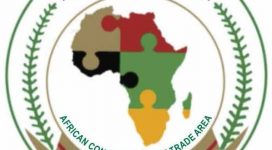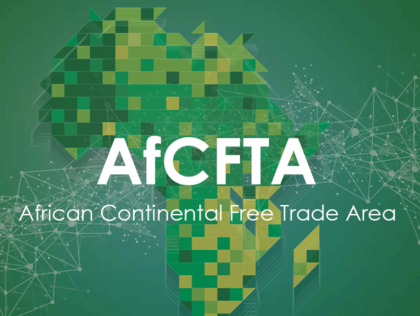CFTA milestone timeline
June 2015: Negotiations launched
February 2016: First negotiating forum held
May 2016: Adoption of 12 negotiating guiding principles
February 2017: First meeting of the 7 technical working groups
July 2017: Agreement to liberalize 90% of products at the sixth negotiating forum
December 2017: Agreement on AfCFTA text and protocol on services
March 2018: Final phase 1 negotiating forum convened
End 2018: Beginning of phase 2 negotiations
- The African Continental Free Trade Area (AfCFTA) will cover a market of 1.2 billion people and a gross domestic product (GDP) of $2.5 trillion, across all 55 member States of the African Union.
- The population of Africa is projected to reach 2.5 billion by 2050, at which point it will comprise 26 per cent of what is projected to be the world’s working age population, with an economy that is estimated to grow twice as rapidly as that of the developed world.
- With average tariffs of 6.1 per cent, businesses currently face higher tariffs when they export within Africa than when they export outside it. AfCFTA will progressively eliminate tariffs on intra-African trade, making it easier for African businesses to trade within the continent and cater to and benefit from the growing African market.
- The UNECA estimates that AfCFTA has the potential both to boost intra-African trade by 52.3 per cent by eliminating import duties, and to double this trade if non-tariff barriers are also reduced.
- Africa’s industrial exports are forecast to benefit most from AfCFTA. This is important for diversifying Africa’s trade and encouraging a move away from extractive commodities, such as oil and minerals, which have traditionally accounted for most of Africa’s exports, towards a more balanced and sustainable export base.
- Perhaps most importantly, AfCFTA will also produce more jobs for Africa’s bulging youth population. This is because extractive exports, on which Africa’s trade is currently based, are less labour intensive than the manufactures and agricultural goods that will benefit most from AfCFTA. By promoting more labour intensive trade, AfCFTA creates more employment.
- While African countries that are relatively more industrialized are well placed to take advantage of the opportunities for manufactured goods, less-industrialized countries can benefit from linking into regional value chains. Regional value chains involve larger industries sourcing their supplies from smaller industries across borders. AfCFTA makes the formation of regional value chains easier by reducing trade costs and facilitating investment.
- Agricultural countries can gain from satisfying Africa’s growing food security requirements. The perishable nature of many agricultural food products means that they are particularly responsive to improvements in customs clearance times and lo-gistics that are expected of AfCFTA.
- The majority of African countries are classified as resource rich. Tariffs on raw materials are already low and so AfCFTA can do little to further promote these exports. However, by lowering intra-African tariffs on intermediates and final goods, AfCFTA will create additional opportunities for adding value to natural resources and for diversifying into new business areas.
- The Boosting Intra African Trade (BIAT) Action Plan is the principal accompanying measure for AfCFTA. It outlines the areas in which investments are required, such as trade information and access to finance, to ensure that all African countries can benefit from AfCFTA.
- AfCFTA is a flagship project of Agenda 2063 of the African Union — Africa’s own development vision. It was approved by the African Union Summit as an urgent initiative whose immediate implementation would provide quick wins, impact on socioeconomic development and enhance confidence and the commitment of Africans as the owners and drivers of Agenda 2063.
- What does AfCFTA mean in concrete terms?
- African businesses, traders and consumers will no longer pay tariffs on a large variety of goods that they trade between African countries;
- Traders constrained by non-tariff barriers, including over-ly burdensome customs procedures or excessive paperwork, will have a mechanism through which to seek the removal of such burdens;
- Cooperation between customs authorities over product standards and regulations, as well as trade transit and facilitation, will make it easier for goods to flow between Africa’s borders;
- Through the progressive liberalization of services, service suppliers will have access to the markets of all African countries on terms no less favourable than domestic suppliers;
- Mutual recognition of standards, licensing and certification of service suppliers will make it easier for businesses and individuals to satisfy the regulatory requirements of operating in each other’s markets;
- The easing of trade between African countries will facilitate the establishment of regional value chains in which inputs are sourced from different African countries to add value before ex-porting externally;
- To protect against unanticipated trade surges, State Parties will have recourse to trade remedies to ensure that domestic industries can be safeguarded, if necessary;
- A dispute settlement mechanism provides a rule-based av-enue for the resolution of any disputes that may arise between State Parties in the application of the agreement;
Upon conclusion, the “Phase two” negotiations will provide a more conducive environment for recognizing African intellectual property rights, facilitating intra-African investment, and ad-dressing anti-competitive challenges.
*Excerpts from a compilation by the African Trade Policy Centre (ATPC) of the Economic Commission for Africa (ECA) in association with the African Union Commission.



